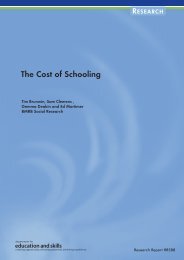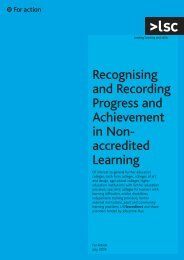<strong>Faiths</strong> <strong>and</strong> Further Education:A H<strong>and</strong>bookAn IntegratedApproach to Chaplaincy102This section is aimed specifically at all those responsible –principals, college managers, chaplains <strong>and</strong> faith bodies – fordeveloping chaplaincies <strong>and</strong> drawing up agreements.103The <strong>and</strong> NEAFE are keen to encourage an integrated approach tochaplaincy, involving the college in terms <strong>of</strong> managers <strong>and</strong> teachingstaff, chaplaincy <strong>and</strong> local faith communities.This section exploresthe form <strong>of</strong> such an integrated approach <strong>and</strong> how it may beexpressed in service level agreements <strong>and</strong> codes <strong>of</strong> practice.As eachcollege has its own context, structure, aims <strong>and</strong> issues, this sectionseeks to <strong>of</strong>fer general guidance. Specific illustrations drawn fromactual college–chaplaincy partnerships or agreements can be foundin the Annexes D <strong>and</strong> E.The following paragraphs are aimed atmembers <strong>of</strong> chaplaincy teams.Underst<strong>and</strong>ing the college, its mission<strong>and</strong> context104All partners will have to share an underst<strong>and</strong>ing <strong>of</strong> how the FEcollege functions. In Section 2 <strong>of</strong> the H<strong>and</strong>book, the importance <strong>of</strong>the college atmosphere in assisting students’ learning <strong>and</strong>enjoyment <strong>of</strong> the college experience was noted.This atmospherecomes about through relationships in <strong>and</strong> outside the classroom,<strong>and</strong> also through the college’s structures, ethos <strong>and</strong> decisionmaking.Being able to analyse what is happening <strong>and</strong> why in thecollege is especially important if the chaplain is not part <strong>of</strong> theformal hierarchy.105A useful start is to examine <strong>and</strong> analyse what the college saysabout itself <strong>and</strong> what it does.The college’s mission statementprovides an explicit statement <strong>and</strong> many other clues about itsimplicit values.Underst<strong>and</strong>ing mission statements106What does a mission statement contain? The college’s missionstatement comes from a collective analysis <strong>of</strong> the college’s purpose<strong>and</strong> the stories it tells itself about its values. In this way, the missionstatement should be an expression <strong>of</strong> the college’s uniqueness.107The following extracts from college mission statements may behelpful (cited in Turner <strong>and</strong> Kimber pp 56–58.The college aims to pursue excellence within a caring environmentby encouraging the spiritual, moral, intellectual, social <strong>and</strong>personal development <strong>of</strong> all individual members <strong>of</strong> both staff <strong>and</strong>students. (Long Road Sixth Form College)As a way <strong>of</strong> ensuring equality <strong>of</strong> opportunity, we maintain thecollege as a secular environment; i.e .we do not endorse anyreligion, faith or culture. This enables us to be as fair as possible inour treatment <strong>of</strong> students … This does not mean we wish topromote a secular way <strong>of</strong> life. (New College, Swindon, StudentCharter)108See Whole People Matter (Turner <strong>and</strong> Kimber, 2003, pp. 54–62) for<strong>further</strong> examples <strong>of</strong> college policies <strong>and</strong> mission statements.Action points:• What does the mission statement <strong>of</strong> your college say?• What do other documents say, for example, college prospectus,student guide?• Does the college make any specific statements about values orspirituality?• What is its policy on diversity? Does it take a multi-faith stance?College aims <strong>and</strong> goals: where chaplaincy fits in109We spend most <strong>of</strong> our lives in organisations <strong>and</strong> tend to take themfor granted. One definition <strong>of</strong> an organisation is:‘a social unit (orhuman grouping) deliberately constructed to seek specific goals’.The college’s aims <strong>and</strong> goals can be identified from an examination<strong>of</strong> the college’s documents. Its values, purpose <strong>and</strong> main areas <strong>of</strong>activity will also be made explicit.“I encourage my chaplain to accept invitations to speak<strong>and</strong> preach anywhere – it’s a great way to advertisethe college.As a result I have been invited to speak tothe Sikh gurdwara <strong>and</strong> Hindu temple.” (Principal)110Even the simplest organisational analysis will tell you a great dealabout the institution in which you are working <strong>and</strong> in what wayspeople are encouraged <strong>and</strong> expected to behave.
35Action point:• Find a copy <strong>of</strong> your college’s organisational chart or similardocument.• What is the shape <strong>of</strong> your college? How many levels are therebetween top <strong>and</strong> bottom?• How are its activities organised? What are the main collegestructures?• Who is responsible for what <strong>and</strong> to whom?111Your college’s organisational chart or prospectus representsschematically the formal structure <strong>of</strong> your <strong>education</strong>al institution.It shows how work has been divided up <strong>and</strong> who is responsible forparticular sections.112Colleges also develop particular <strong>and</strong> expected ways <strong>of</strong> doings things<strong>and</strong> interacting with each other —an organisational culture. It canproduce a sense <strong>of</strong> collective identity, foster stability <strong>and</strong> influencebehaviour.The elements <strong>of</strong> organisational culture comprise:• structure <strong>and</strong> systems• leadership <strong>and</strong> management styles• values, beliefs <strong>and</strong> assumptions• stories, myths <strong>and</strong> rituals.Action points:Think about your college. In what terms do people within it talkabout it? In analysing a college’s stories or folklore about itself, itcan be useful to identify:• the core beliefs (for example,‘this is a very caring organisation’,‘we’re at the cutting edge’,‘they couldn’t run a whelk stall’)• whether those beliefs are held by those at the top <strong>of</strong> theorganisation <strong>and</strong> those at the bottom – <strong>and</strong> those in between.As you continue to work at the college, you will need to identify:• your friends• the people you need to influence• the people that students connect with.113Having considered your institution in general organisational terms,ask some more specific questions.• What is the college’s leadership style?• What is the college’s organisational climate? What is theemotional climate?• What is the college’s track record?• What are the strengths <strong>and</strong> weaknesses?• What policies relate to values (for example, the environment)?• How is its student body constituted?• What is the college’s role in the community?What are other relevant factors, such as demographic, social,economic, cultural, technological <strong>and</strong> industrial?“Boys from Black <strong>and</strong> Muslim backgrounds had a veryhigh drop-out rate.We asked for help from the localBlack church <strong>and</strong> the mosque, <strong>and</strong> in both cases,managed to recruit a mentor who has become amember <strong>of</strong> the chaplaincy team.They use groupmentoring methods, which have been very successfulin driving up attendance hugely.” (Chaplain)114A snapshot is developing <strong>of</strong> the college as it is at the moment. Ourunderst<strong>and</strong>ing <strong>of</strong> the issues it faces now can be deepened if weunderst<strong>and</strong> how the college has developed over time.Thesequestions may help.• What are the college’s current priorities? What are its plans forthe future?• Has its mission <strong>and</strong> strategy changed over time?• Has its course <strong>of</strong>fer changed?• Have its relationships with employers changed?• Has its local community, <strong>and</strong> its relations with the communitychanged?• Has its student body changed?• Has the structure <strong>of</strong> the college changed? For example, has therebeen an amalgamation or restructuring?Why this is relevant115It is with this deeper underst<strong>and</strong>ing <strong>of</strong> the college, its staff <strong>and</strong>students that the chaplaincy can engage in its primary focus interms <strong>of</strong> pastoral care <strong>and</strong> spiritual development. But suchorganisational knowledge is also important when members <strong>of</strong> thechaplaincy discuss with the college its organisation, or itscommitment to a multi-faith approach.Action point:You have studied the college. Now look back at Section 1, thechecklist for setting up or strengthening a chaplaincy.• What stage have you reached?• What do you need to do next?
















